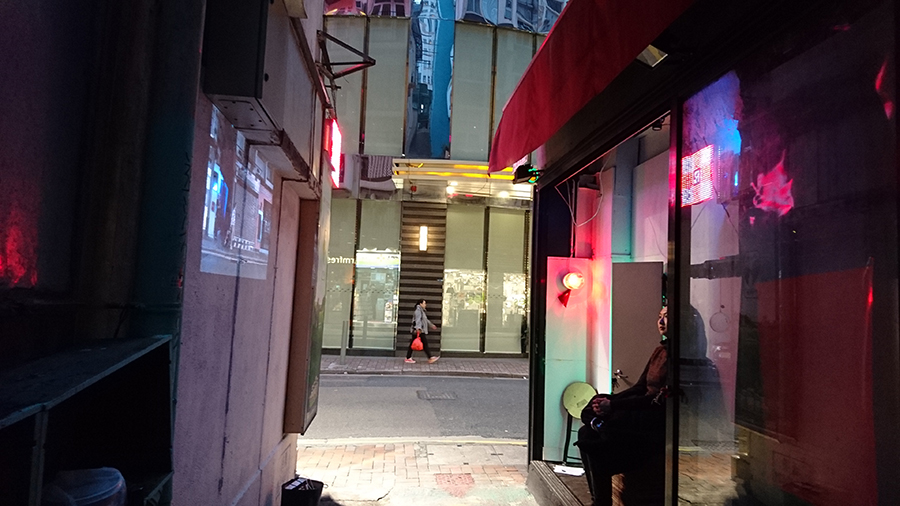Walk With Me
From artist Enoch Cheng’s nocturnal balletics to fascist violence in Charlottesville, rethinking the political agency of walking
From artist Enoch Cheng’s nocturnal balletics to fascist violence in Charlottesville, rethinking the political agency of walking

Imagine you are invited to a performance. You arrive in the evening at the chosen venue: an obscure back lane hidden behind the densely packed shopping malls of Hong Kong’s Causeway Bay. But you discover that the artist is not there. Instead you join a group of six people you do not know huddled around a woman holding a walkie-talkie, from which a fuzzy voice issues a command. ‘Walk with me,’ it says. You trail the walkie-talkie holder as she roams, seemingly aimlessly, following cryptic directions emitted through the device. You walk for 20 minutes, maybe 30, until you arrive at a cross-harbour bus station. It transpires that you are expected to board a bus, without knowing where to, and with absolutely no certainty of what calibre of art to expect. You have dinner plans. The night is muggy and you have started to sweat. Do you board, or do you leave?

I chose to board, on that warm spring evening in 2016, but not without considerable hesitation. Nothing dramatic or extraordinary awaited: our entourage eventually arrived at a remote promenade outside a pyramid-shaped stadium – the Hong Kong Coliseum in Kowloon – where we found Hong Kong-based artist and curator Enoch Cheng performing an eccentric solo dance in the dark. At the conclusion of Cheng’s A Passage (2016), I departed feeling bemused, hungry and ever so slightly disgruntled; and yet a lingering impression persisted – one that grew stronger with every recollection.

I’ve been thinking again about Cheng’s piece – triggered in part by his burgeoning presence in the art scene and by recent street protests over jailed democracy activists here in Hong Kong, as well as the tragic consequences of the white supremacist rally in Charlottesville – and re-examining it in the context of the agency of walking. Various artists over the years have explored walking as an aesthetic and conceptual strategy, resulting in a genre extensively explored in the imminent exhibition ‘Wanderlust: Actions, Traces, Journeys 1967-2017’ at UB Art Galleries in Buffalo, New York. Cheng’s experiential A Passage, however, hones in specifically on the idea of ‘following’: a subspecies of walking per se that was central to the late Vito Acconci’s canonical Following Piece (1969) at the dawn of conceptual art in the late 1960s. In that work, Acconci shadowed random people around the streets of New York, stopping only until they entered a private space, and documented his adventures through detailed notes. For the American artist, the experience of tailing strangers was a way to subject his body and movements to external and uncertain forces. In one journal entry Acconci wrote: ‘I add myself to another person (I give up control/I don’t have to control myself)’. In another: ‘Out of space. Out of time. (My time and space are taken up, out of myself, into a larger system)’.

Such an ‘out of self’ experience was manifested in a different way in another celebrated (and indeed, sensationalized) walking work: Marina Abramović and Ulay’s collaborative The Lovers: The Great Wall Walk (1988). Starting from opposite ends of the Great Wall in China, the ex-lovers walked towards each other over 90 days in an extended pilgrimage of artistic and personal commitment. In their ‘following’ of a predetermined trail, their respective journeys nevertheless embodied palpable uncertainty in outcome: what did each step closer to each other bring to their notoriously turbulent relationship? With each stride taken in solitude, yet ‘appended’ to the other person’s trajectory (not unlike how Acconci ‘added’ himself to another person), Abramović and Ulay walked independently yet in accord, together in their solitude, forming – again borrowing Acconci’s words – something of ‘a larger system’.

The more I think about these works, the more I wonder: could such a ‘walking-with’ – a loose choreography or ‘appendage’ that straddles the ‘walking-alone’ (for instance, a philosopher’s solitary stroll) and the ‘walking-together’ (the march of a mob) – acquire a new social or political agency? Conceptualized via elusive ‘followings’, ambiguous rendezvous and singular yet vaguely connected journeys, the walking-with departs from the traditional militant walking-together in that the latter almost necessarily entails a vehement and unequivocal walking-against – a mode of resistance that increasingly runs the risk of intensifying ‘Us versus Them’ dichotomies to a point of dehumanized monstrosity. In light of resurgent white-supremacist marches and rallies, the once emancipative notion of bodies collectively taking to the streets – or that of ‘assemblies’ and bodies ‘acting in concert’, per Judith Butler in Notes Toward a Performative Theory of Assembly (2015) – now seems irrevocably tainted (or indeed appropriated) by fascist persecution and terror. Within such toxic climates, do we still walk, as they do – how, and with whom?

These are the critical questions posed by the act of walking-with, which, recalling my experience with Cheng’s A Passage, is principally defined by doubt, scepticism and a persistent interrogation that accompanies every conscious step. In place of solidarity or an unambiguous ‘Us’, diverse bodies are associated and connected instead via a new militant logic: their constant critical negotiations between Self and Other, Togetherness and Apartness, ‘my road’ and ‘your road’ – bonded through collective engagements with the unknown. Recall Acconci’s Following Piece: in his ‘adding’ of himself to another person, or his shifting of himself into ‘a larger system’, at every moment he was conscious, mindful, at liberty to not follow – his every choice to continue constituting his intangible connection with his followee. The same goes for Abramović and Ulay in their precarious reunion, as well as all the participants in A Passage: along with my fellow walkers, my entire experience that evening was an extended (slightly impatient, admittedly) debate between staying with or leaving, continuing together or giving up, walking on or walking away.

The militant logic of the walking-with separates it from the mob or the herd – derived not merely from inclusivity and diversity, which itself accounts for plural emancipative potentials, but more so in the thinking vigilance of its willing, walking, resisting bodies. With each choice and step, however hesitant, walking-with retains the discerning thought spaces of each resistant unit (different groups in a protest; activists asserting varying values) whilst coaxing them into overlapping and interdependent rhythms of contingent, indeterminate and propitious lines of flight. Here, chaos and uncertainty are givens: in an age that Ernesto Laclau called ‘post-emancipatory’ – where the battle against authority or oppression can never be a total negation but at most a mass heterogeneous subversion – antagonism must necessarily be infinitely multitudinous. In response to my anxieties over the increasingly extremist ideals and behaviour of neighbouring protesting camps in Hong Kong, a fellow marcher replied that perhaps therein lay the multitude’s prerogative, and that in such circumstances, continued vigilant navigation becomes key.

Returning to Cheng’s A Passage, the artist reflects that he constructed the experimental participatory performance to offer participants a chance of a ‘genuine, yet safe, engagement with the unknown’ – a mode of engagement he observes as only possible within the space of art. In moments of protest and resistance, the physical and emotional precarity involved recalls that of travellers of ages past venturing towards unknown ‘promised lands’; Samson Young’s recent One of Two Stories, or Both (Field Bagatelles) (2017) comes to mind – a radio series and installation inspired by tales of 17th century Chinese travellers who allegedly trekked to Europe on foot. Ultimately, walking-with as a mode of resistance positions us not as marchers but travellers embarking on separate yet connected pilgrimages, submitting ourselves to spaces of open-ended uncertainty, grounded only in the knowledge of the pivotal agency of each precarious step. The stakes are high and the perils rife: with whom are you walking, and to where?
Main image: Efrat Natan, Head Sculpture, 1973, performance documentation. Courtesy: the artist and UB Art Galleries























